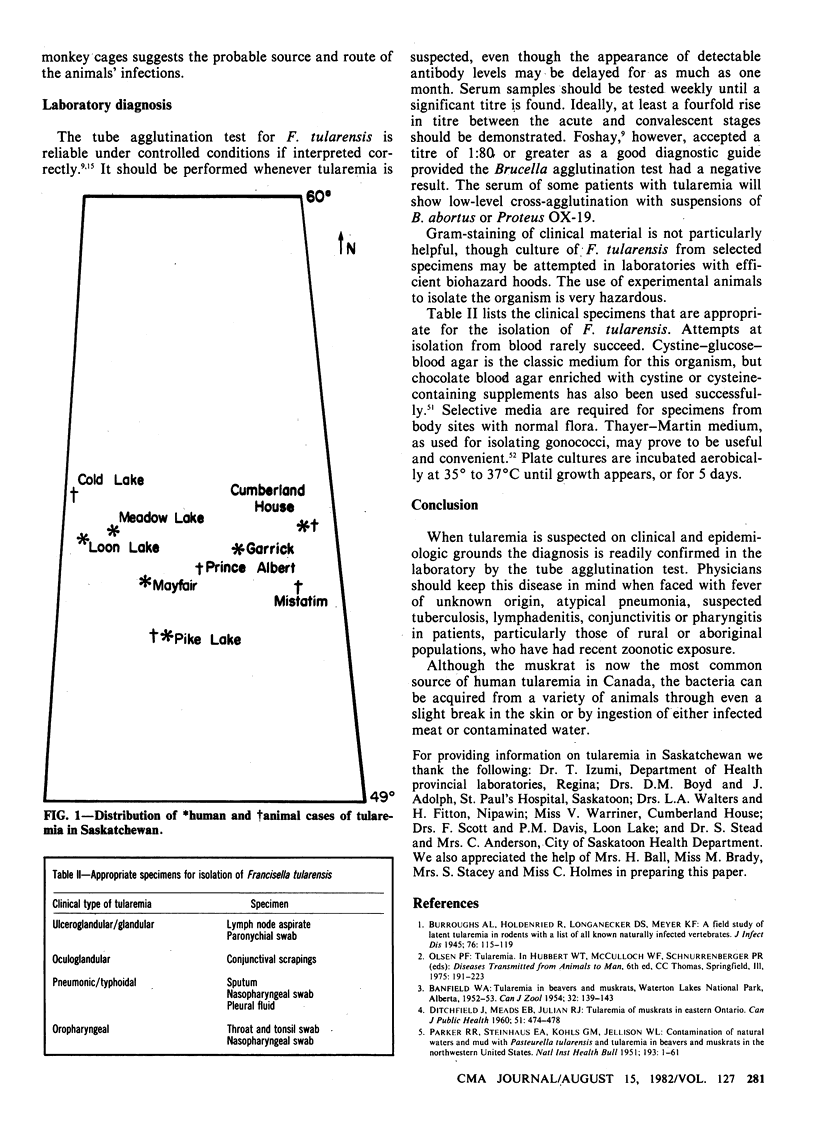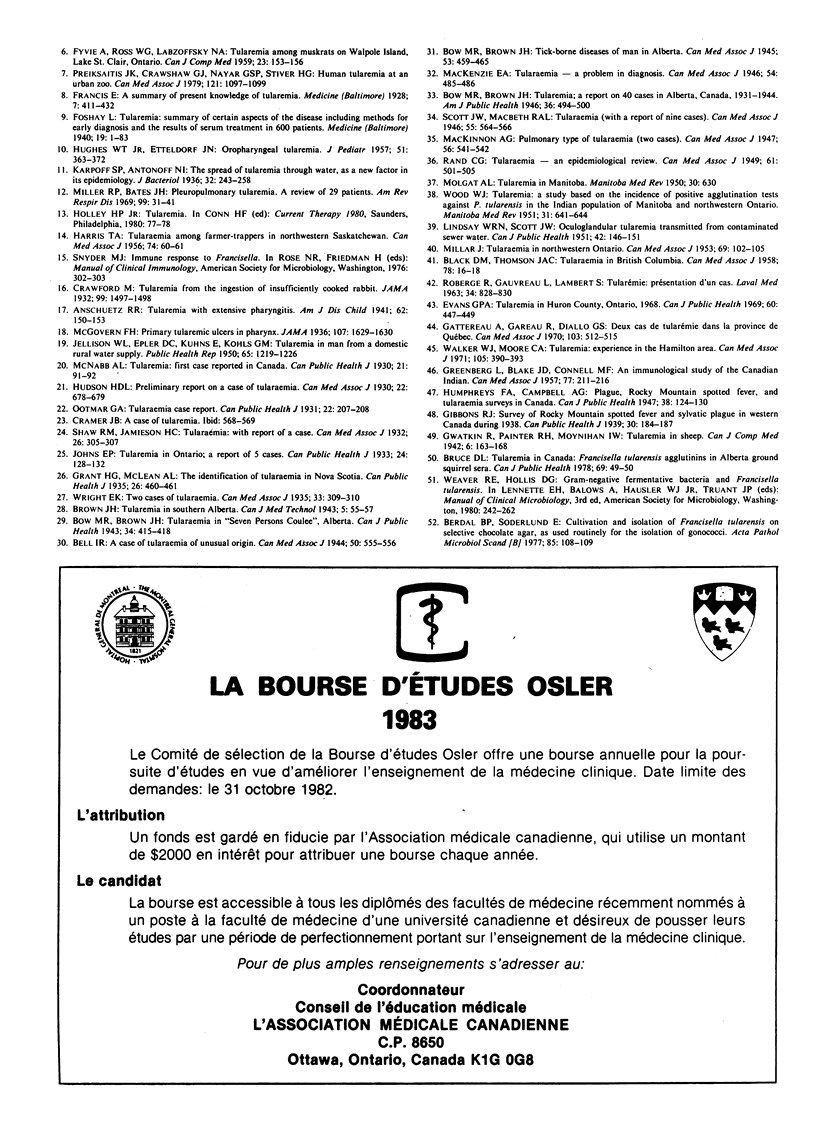Abstract
Although rare among humans in Canada, tularemia is often endemic in wildlife. The inhabitants of rural areas are especially likely to be exposed to the causative bacterium, Francisella tularensis, through trapping or through the bites of arthropods. Muskrats have replaced rabbits as the principal source of infection, as illustrated by a familial outbreak of oropharyngeal tularemia in Saskatchewan. In humans the disease has six distinct forms and can be asymptomatic, but it generally comes to medical attention as fever, persistent ulcers and enlarged lymph nodes. Serologic tests will confirm the diagnosis.
Bien que la tularémie soit rare chez l'homme au Canada, elle existe souvent à l'état endémique parmi les animaux sauvages. Les habitants des régions rurales sont particuliérement susceptibles d'être exposés à l'agent étiologique, Francisella tularensis, lors du trappage ou par les morsures d'arthropodes. Le rat musqué a maintenant remplacé le lapin comme principale source d'infection, tel que l'illustre une poussée de tularémie oropharyngienne chez une famille de Saskatchewan. Chez l'humain la maladie prend six formes distinctes, et elle peut être asymptomatique, mais elle se présente généralement à l'attention du médecin comme une fièvre accompagnée d'ulcères persistants et d'une tuméfaction ganglionnaire. Les épreuves sérologiques confirment le diagnostic.
Full text
PDF



Selected References
These references are in PubMed. This may not be the complete list of references from this article.
- BLACK D. M., THOMSON J. A. Tularaemia in British Columbia. Can Med Assoc J. 1958 Jan 1;78(1):16–18. [PMC free article] [PubMed] [Google Scholar]
- Berdal B. P., Soderlund E. Cultivation and isolation of Francisella tularensis on selective chocolate agar, as used routinely for the isolation of gonoccocci. Acta Pathol Microbiol Scand B. 1977 Feb;85B(1):108–109. doi: 10.1111/j.1699-0463.1977.tb01681.x. [DOI] [PubMed] [Google Scholar]
- Bow M. R., Brown J. H. Tick-Borne Diseases of Man in Alberta. Can Med Assoc J. 1945 Nov;53(5):459–465. [PMC free article] [PubMed] [Google Scholar]
- Bow M. R., Brown J. H. Tularemia. A Report on 40 Cases in Alberta, Canada, 1931-1944. Am J Public Health Nations Health. 1946 May;36(5):494–500. [PMC free article] [PubMed] [Google Scholar]
- Bruce D. L. Tularemia in Canada: Francisella tularensis agglutinins in Alberta ground squirrel sera. Can J Public Health. 1978 Jan-Feb;69(1):49-50, 53. [PubMed] [Google Scholar]
- DITCHFIELD J., MEADS E. B., JULIAN R. J. Tularemia of muskrats in Eastern Ontario. Can J Public Health. 1960 Dec;51:474–478. [PubMed] [Google Scholar]
- Evans G. P. Tularemia in Huron County, Ontario, 1968. Can J Public Health. 1969 Nov;60(11):447–449. [PubMed] [Google Scholar]
- Fyvie A., Ross W. G., Labzoffsky N. A. Tularemia Among Muskrats On Walpole Island, Lake St. Clair, Ontario. Can J Comp Med Vet Sci. 1959 May;23(5):153–156. [PMC free article] [PubMed] [Google Scholar]
- GREENBERG L., BLAKE J. D. An immunological study of the Canadian Indian. Can Med Assoc J. 1957 Aug 1;77(3):211–216. [PMC free article] [PubMed] [Google Scholar]
- Gattereau A., Gareau R., Diallo G. S. Deux cas de tularémie dans la province de Québec. Can Med Assoc J. 1970 Sep 12;103(5):512–515. [PMC free article] [PubMed] [Google Scholar]
- Gwatkin R., Painter R. H., Moynihan I. W. Tularaemia in Sheep. Can J Comp Med Vet Sci. 1942 Jun;6(6):163–168. [PMC free article] [PubMed] [Google Scholar]
- HARRIS T. A. Tularaemia among farmer-trappers in northwestern Saskatchewan. Can Med Assoc J. 1956 Jan 1;74(1):60–61. [PMC free article] [PubMed] [Google Scholar]
- HUGHES W. T., Jr, ETTELDORF J. N. Oropharyngeal tularemia. J Pediatr. 1957 Oct;51(4):363–372. doi: 10.1016/s0022-3476(57)80119-x. [DOI] [PubMed] [Google Scholar]
- Hudson H. D. PRELIMINARY REPORT ON A CASE OF TULARAEMIA. Can Med Assoc J. 1930 May;22(5):678–679. [PMC free article] [PubMed] [Google Scholar]
- JELLISON W. L., EPLER D. C., KUHNS E., KOHLS G. M. Tularemia in man from a domestic rural water supply. Public Health Rep. 1950 Sep 22;65(38):1219–1226. [PubMed] [Google Scholar]
- Karpoff S. P., Antonoff N. I. The Spread of Tularemia through Water, as a New Factor in Its Epidemiology. J Bacteriol. 1936 Sep;32(3):243–258. doi: 10.1128/jb.32.3.243-258.1936. [DOI] [PMC free article] [PubMed] [Google Scholar]
- LINDSAY W. R. N., SCOTT J. W. Oculoglandular tularemia transmitted from contaminated sewer water. Can J Public Health. 1951 Apr;42(4):146–151. [PubMed] [Google Scholar]
- MILLAR J. Tularaemia in Northwestern Ontario. Can Med Assoc J. 1953 Aug;69(2):102–105. [PMC free article] [PubMed] [Google Scholar]
- MOLGAT A. L. Tularemia in Manitoba. Manit Med Rev. 1950 Nov;30(9):630–630. [PubMed] [Google Scholar]
- MacKINNON A. G. Pulmonary type of tularaemia; two cases. Can Med Assoc J. 1947 May;56(5):541–541. [PMC free article] [PubMed] [Google Scholar]
- Mackenzie E. A. TULARAEMIA-A PROBLEM IN DIAGNOSIS. Can Med Assoc J. 1946 May;54(5):485–486. [PMC free article] [PubMed] [Google Scholar]
- Miller R. P., Bates J. H. Pleuropulmonary tularemia. A review of 29 patients. Am Rev Respir Dis. 1969 Jan;99(1):31–41. doi: 10.1164/arrd.1969.99.1.31. [DOI] [PubMed] [Google Scholar]
- Preiksaitis J. K., Crawshaw G. J., Nayar G. S., Stiver H. G. Human tularemia at an urban zoo. Can Med Assoc J. 1979 Oct 20;121(8):1097–1099. [PMC free article] [PubMed] [Google Scholar]
- RAND C. G. Tularaemia; an epidemiological review. Can Med Assoc J. 1949 Nov;61(5):501–505. [PMC free article] [PubMed] [Google Scholar]
- ROBERGE R., GAUVREAU L., LAMBERT S. TULAR'EMIE: PR'ESENTATION D'UN CAS. Laval Med. 1963 Sep;34:828–830. [PubMed] [Google Scholar]
- SCOTT J. W., MACBETH R. A. L. Tularaemia (with a report of nine cases). Can Med Assoc J. 1946 Dec;55(6):564–566. [PMC free article] [PubMed] [Google Scholar]
- Shaw R. M., Jamieson H. C. TULARAEMIA: With Report of a Case. Can Med Assoc J. 1932 Mar;26(3):305–307. [PMC free article] [PubMed] [Google Scholar]
- WOOD W. J. Tularemia; a study based on the incidence of positive agglutination tests against P. tularensis in the Indian population of Manitoba and North-Western Ontario. Manit Med Rev. 1951 Dec;31(10):641–644. [PubMed] [Google Scholar]
- Walker W. J., Moore C. A. Tularemia: experience in the Hamilton area. Can Med Assoc J. 1971 Aug 21;105(4):390–passim. [PMC free article] [PubMed] [Google Scholar]
- Wright E. K. Two Cases of Tularaemia. Can Med Assoc J. 1935 Sep;33(3):309–310. [PMC free article] [PubMed] [Google Scholar]


